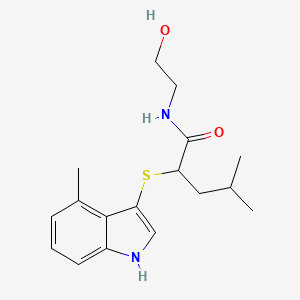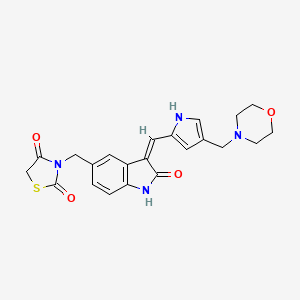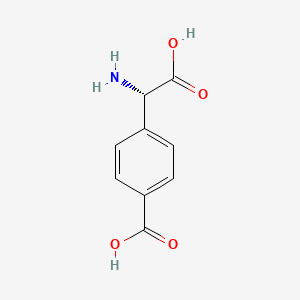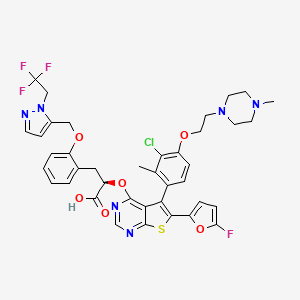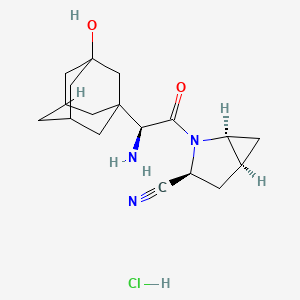
Saxagliptin hydrochloride
説明
サクサグリプチン塩酸塩は、2型糖尿病の管理に使用される経口活性降血糖薬です。これは、ジペプチジルペプチダーゼ-4(DPP-4)阻害剤のクラスに属し、体内のインクレチンホルモンのレベルを上昇させることで作用します。 これらのホルモンは、インスリン産生を増加させ、肝臓によるグルコース産生を減少させることで、血糖値を調節するのに役立ちます .
2. 製法
合成経路と反応条件: サクサグリプチン塩酸塩の合成には、いくつかの重要なステップが含まれます。一般的な方法の1つは、カップリング試薬の存在下で2つのアミノ酸誘導体をカップリングすることです。 (S)-(+)-p-トルエンスルホンアミド、チタン(IV)エトキシド、アダマンタン-1-カルボキシアルデヒドをカップリングしてヒドロキシベンゾトリアゾールおよびEDC(1-エチル-3-(3-ジメチルアミノプロピル)カルボジイミド)を得るアミドカップリングは、重要なステップです .
工業的製造方法: サクサグリプチン塩酸塩の工業的製造は、しばしば、化合物の定量および確認のために、高性能液体クロマトグラフィー(HPLC)の使用が含まれます。 この方法は、最終製品の純度と品質を保証します .
生化学分析
Biochemical Properties
Saxagliptin hydrochloride plays a crucial role in biochemical reactions by inhibiting the DPP-4 enzyme. This inhibition prevents the degradation of incretin hormones such as glucagon-like peptide-1 (GLP-1) and glucose-dependent insulinotropic polypeptide (GIP). By maintaining higher levels of these hormones, this compound enhances insulin secretion and decreases glucagon release, leading to improved glycemic control . The compound interacts with the DPP-4 enzyme by forming a reversible, histidine-assisted covalent bond between its nitrile group and the serine residue in the active site of DPP-4 .
Cellular Effects
This compound influences various cellular processes, particularly in pancreatic beta cells. By inhibiting DPP-4, it increases the levels of GLP-1 and GIP, which in turn stimulate insulin secretion from beta cells. This leads to improved glucose uptake and utilization by cells, thereby lowering blood glucose levels . Additionally, this compound has been shown to have minimal effects on cell signaling pathways and gene expression, making it a relatively safe option for long-term use .
Molecular Mechanism
The molecular mechanism of this compound involves the inhibition of the DPP-4 enzyme. This enzyme is responsible for the degradation of incretin hormones. By inhibiting DPP-4, this compound increases the half-life of GLP-1 and GIP, enhancing their biological effects . The compound forms a reversible covalent bond with the active site of DPP-4, which prevents the enzyme from degrading incretin hormones .
Temporal Effects in Laboratory Settings
In laboratory settings, the effects of this compound have been observed over various time periods. The compound is stable and maintains its inhibitory effects on DPP-4 for up to 24 hours post-administration . Long-term studies have shown that this compound remains effective in improving glycemic control without significant degradation or loss of potency .
Dosage Effects in Animal Models
In animal models, the effects of this compound vary with different dosages. At lower doses, the compound effectively inhibits DPP-4 and improves glycemic control without adverse effects . At higher doses, this compound may cause toxic effects, including gastrointestinal disturbances and potential hepatotoxicity . It is important to determine the optimal dosage to maximize therapeutic benefits while minimizing adverse effects.
Metabolic Pathways
This compound is primarily metabolized by the cytochrome P450 3A4/5 (CYP3A4/5) enzymes in the liver . The major metabolite, 5-hydroxy saxagliptin, retains some inhibitory activity against DPP-4 but is less potent than the parent compound . The metabolic pathways involve hydroxylation and subsequent conjugation reactions, leading to the formation of various metabolites that are excreted via urine and feces .
Transport and Distribution
This compound is well-absorbed and distributed throughout the body. It has a bioavailability of approximately 75% and reaches peak plasma concentrations within 2 hours of oral administration . The compound is primarily excreted through the urine, with a smaller portion eliminated via the bile . This compound does not significantly bind to plasma proteins, allowing for efficient distribution to target tissues .
Subcellular Localization
The subcellular localization of this compound is primarily within the cytoplasm, where it interacts with the DPP-4 enzyme . The compound does not require specific targeting signals or post-translational modifications for its activity. Its inhibitory effects on DPP-4 are exerted directly within the cytoplasmic compartment, leading to increased levels of active incretin hormones .
準備方法
Synthetic Routes and Reaction Conditions: The synthesis of Saxagliptin Hydrochloride involves several key steps. One common method includes the coupling of two amino acid derivatives in the presence of a coupling reagent. The amide coupling of (S)-(+)-p-toluenesulfonamide, titanium(IV) ethoxide, and adamantane-1-carboxaldehyde to obtain hydroxybenzotriazole and EDC (1-ethyl-3-(3-dimethylaminopropyl)carbodiimide) is a crucial step .
Industrial Production Methods: Industrial production of this compound often involves the use of high-performance liquid chromatography (HPLC) for the quantification and validation of the compound. This method ensures the purity and quality of the final product .
化学反応の分析
反応の種類: サクサグリプチン塩酸塩は、次のようなさまざまな化学反応を起こします。
酸化: この反応は、酸素の付加または水素の除去を含みます。
還元: この反応は、水素の付加または酸素の除去を含みます。
置換: この反応は、1つの原子または原子団を別の原子または原子団で置き換えることを含みます。
一般的な試薬と条件: これらの反応で使用される一般的な試薬には、過マンガン酸カリウムなどの酸化剤、水素化ホウ素ナトリウムなどの還元剤、ハロゲンなどの置換試薬があります。 これらの反応の条件は、通常、目的の結果を確保するために、制御された温度とpHレベルを伴います .
生成される主な生成物: これらの反応から生成される主な生成物には、サクサグリプチン塩酸塩の合成に不可欠なさまざまな中間体があります。 これらの中間体は、その後、最終化合物を得るためにさらに処理されます .
4. 科学研究への応用
サクサグリプチン塩酸塩は、幅広い科学研究への応用があります。
化学: 酵素阻害剤とその代謝経路への影響に関する研究に使用されます。
生物学: グルコース調節におけるインクレチンホルモンの役割を理解するために使用されます。
医学: 主に、血糖コントロールを改善するために、2型糖尿病の治療に使用されます。
科学的研究の応用
Saxagliptin Hydrochloride has a wide range of scientific research applications:
Chemistry: It is used in the study of enzyme inhibitors and their effects on metabolic pathways.
Biology: It is used to understand the role of incretin hormones in glucose regulation.
Medicine: It is primarily used in the treatment of type 2 diabetes mellitus to improve glycemic control.
Industry: It is used in the pharmaceutical industry for the production of antidiabetic medications
作用機序
サクサグリプチン塩酸塩は、ジペプチジルペプチダーゼ-4(DPP-4)酵素を阻害することで作用します。この阻害は、グルカゴン様ペプチド-1(GLP-1)およびグルコース依存性インスリン分泌促進ポリペプチド(GIP)などのインクレチンホルモンのレベルを上昇させます。 これらのホルモンは、インスリン分泌を増加させ、肝臓からのグルカゴン分泌を減少させることで、血糖値を下げるのに役立ちます .
類似化合物:
メトホルミン: インスリン感受性を改善する別の抗糖尿病薬。
セマグルチド: インクレチンホルモンの効果を模倣するGLP-1受容体アゴニスト。
比較:
サクサグリプチン塩酸塩対メトホルミン: サクサグリプチン塩酸塩はDPP-4を阻害することで作用しますが、メトホルミンはインスリン感受性を改善します。
サクサグリプチン塩酸塩対セマグルチド: 両方の薬物はインクレチンホルモンのレベルを上昇させますが、セマグルチドはGLP-1受容体アゴニストであり、サクサグリプチン塩酸塩はDPP-4阻害剤です。
サクサグリプチン塩酸塩は、その独特の作用機序と2型糖尿病の併用療法における有効性により際立っています。
類似化合物との比較
Metformin: Another antidiabetic drug that improves insulin sensitivity.
Semaglutide: A GLP-1 receptor agonist that mimics the effects of incretin hormones.
Comparison:
Saxagliptin Hydrochloride vs. Metformin: this compound works by inhibiting DPP-4, while Metformin improves insulin sensitivity.
This compound vs. Semaglutide: Both drugs increase the levels of incretin hormones, but Semaglutide is a GLP-1 receptor agonist, while this compound is a DPP-4 inhibitor.
This compound stands out due to its specific mechanism of action and its effectiveness in combination therapies for type 2 diabetes mellitus.
特性
IUPAC Name |
(1S,3S,5S)-2-[(2S)-2-amino-2-(3-hydroxy-1-adamantyl)acetyl]-2-azabicyclo[3.1.0]hexane-3-carbonitrile;hydrochloride | |
|---|---|---|
| Source | PubChem | |
| URL | https://pubchem.ncbi.nlm.nih.gov | |
| Description | Data deposited in or computed by PubChem | |
InChI |
InChI=1S/C18H25N3O2.ClH/c19-8-13-2-12-3-14(12)21(13)16(22)15(20)17-4-10-1-11(5-17)7-18(23,6-10)9-17;/h10-15,23H,1-7,9,20H2;1H/t10?,11?,12-,13+,14+,15-,17?,18?;/m1./s1 | |
| Source | PubChem | |
| URL | https://pubchem.ncbi.nlm.nih.gov | |
| Description | Data deposited in or computed by PubChem | |
InChI Key |
TUAZNHHHYVBVBR-NHKADLRUSA-N | |
| Source | PubChem | |
| URL | https://pubchem.ncbi.nlm.nih.gov | |
| Description | Data deposited in or computed by PubChem | |
Canonical SMILES |
C1C2CC2N(C1C#N)C(=O)C(C34CC5CC(C3)CC(C5)(C4)O)N.Cl | |
| Source | PubChem | |
| URL | https://pubchem.ncbi.nlm.nih.gov | |
| Description | Data deposited in or computed by PubChem | |
Isomeric SMILES |
C1[C@@H]2C[C@@H]2N([C@@H]1C#N)C(=O)[C@H](C34CC5CC(C3)CC(C5)(C4)O)N.Cl | |
| Source | PubChem | |
| URL | https://pubchem.ncbi.nlm.nih.gov | |
| Description | Data deposited in or computed by PubChem | |
Molecular Formula |
C18H26ClN3O2 | |
| Source | PubChem | |
| URL | https://pubchem.ncbi.nlm.nih.gov | |
| Description | Data deposited in or computed by PubChem | |
DSSTOX Substance ID |
DTXSID50991191 | |
| Record name | Saxagliptin hydrochloride | |
| Source | EPA DSSTox | |
| URL | https://comptox.epa.gov/dashboard/DTXSID50991191 | |
| Description | DSSTox provides a high quality public chemistry resource for supporting improved predictive toxicology. | |
Molecular Weight |
351.9 g/mol | |
| Source | PubChem | |
| URL | https://pubchem.ncbi.nlm.nih.gov | |
| Description | Data deposited in or computed by PubChem | |
CAS No. |
709031-78-7 | |
| Record name | Saxagliptin hydrochloride | |
| Source | ChemIDplus | |
| URL | https://pubchem.ncbi.nlm.nih.gov/substance/?source=chemidplus&sourceid=0709031787 | |
| Description | ChemIDplus is a free, web search system that provides access to the structure and nomenclature authority files used for the identification of chemical substances cited in National Library of Medicine (NLM) databases, including the TOXNET system. | |
| Record name | Saxagliptin hydrochloride | |
| Source | EPA DSSTox | |
| URL | https://comptox.epa.gov/dashboard/DTXSID50991191 | |
| Description | DSSTox provides a high quality public chemistry resource for supporting improved predictive toxicology. | |
| Record name | (1S,3S,5S)-2-[(2S)-2-Amino-2-(3-hydroxyadamantan-1-yl)acetyl]-2-azabicyclo[3.1.0]hexane-3-carbonitrile hydrochloride | |
| Source | European Chemicals Agency (ECHA) | |
| URL | https://echa.europa.eu/information-on-chemicals | |
| Description | The European Chemicals Agency (ECHA) is an agency of the European Union which is the driving force among regulatory authorities in implementing the EU's groundbreaking chemicals legislation for the benefit of human health and the environment as well as for innovation and competitiveness. | |
| Explanation | Use of the information, documents and data from the ECHA website is subject to the terms and conditions of this Legal Notice, and subject to other binding limitations provided for under applicable law, the information, documents and data made available on the ECHA website may be reproduced, distributed and/or used, totally or in part, for non-commercial purposes provided that ECHA is acknowledged as the source: "Source: European Chemicals Agency, http://echa.europa.eu/". Such acknowledgement must be included in each copy of the material. ECHA permits and encourages organisations and individuals to create links to the ECHA website under the following cumulative conditions: Links can only be made to webpages that provide a link to the Legal Notice page. | |
| Record name | SAXAGLIPTIN HYDROCHLORIDE | |
| Source | FDA Global Substance Registration System (GSRS) | |
| URL | https://gsrs.ncats.nih.gov/ginas/app/beta/substances/Z8J84YIX6L | |
| Description | The FDA Global Substance Registration System (GSRS) enables the efficient and accurate exchange of information on what substances are in regulated products. Instead of relying on names, which vary across regulatory domains, countries, and regions, the GSRS knowledge base makes it possible for substances to be defined by standardized, scientific descriptions. | |
| Explanation | Unless otherwise noted, the contents of the FDA website (www.fda.gov), both text and graphics, are not copyrighted. They are in the public domain and may be republished, reprinted and otherwise used freely by anyone without the need to obtain permission from FDA. Credit to the U.S. Food and Drug Administration as the source is appreciated but not required. | |
A: Saxagliptin Hydrochloride functions as a dipeptidyl peptidase-4 (DPP-4) inhibitor. [, , , ] This enzyme typically breaks down incretin hormones like glucagon-like peptide-1 (GLP-1) and glucose-dependent insulinotropic polypeptide (GIP). By inhibiting DPP-4, this compound increases the levels of these incretin hormones. This, in turn, stimulates insulin secretion from pancreatic β-cells and suppresses glucagon release, ultimately leading to improved glycemic control. [, , ]
A: this compound is represented by the molecular formula C18H25N3O2·HCl. Its molecular weight is 351.87 g/mol. [, ]
A: Several spectroscopic methods prove valuable in the analysis of this compound. These include: * X-ray powder diffraction (XRPD): This technique is used to identify different crystalline forms of this compound, such as the dihydrate form. [, ] * Fourier transform infrared spectroscopy (FTIR): FTIR aids in confirming the identity of this compound and can also be used to study drug-excipient compatibility. [, , ] * UV-Vis Spectrophotometry: This technique is commonly employed for quantitative analysis of this compound, often in conjunction with HPLC. [, , , , ]
A: this compound exhibits instability due to a tendency for intra-molecular cyclization, forming a cyclicamidine. [] Careful selection of excipients during formulation is crucial to minimize this degradation pathway. [, ] Studies have shown compatibility with excipients like Methocel, Polyethylene Glycol (PEG), and various Opadry polymers. []
A: While the provided research does not offer a detailed SAR analysis, it is understood that even minor structural changes to this compound could alter its binding affinity to DPP-4, thereby affecting its potency and selectivity. [, ] Further research in this area would be valuable.
A: The inherent instability of this compound, particularly its susceptibility to cyclization, poses a significant formulation challenge. [, ] To enhance its stability and bioavailability, various strategies are employed, including the use of suitable excipients, controlled release formulations, and potentially, alternative routes of administration like buccal delivery. [, , , ]
A: this compound undergoes significant hepatic metabolism. []
A: It possesses an elimination half-life of approximately 2.5 hours. [] This relatively short half-life necessitates regular dosing to maintain therapeutic levels.
A: Yes, research supports the efficacy of this compound in managing Type 2 Diabetes. [, ] While specific details on preclinical models and clinical trials are not provided in the research excerpts, it is understood that the compound has been tested in both settings.
A: While the research excerpts do not specifically mention targeted delivery systems for this compound, the development of buccal patches for this drug suggests exploration of alternative routes of administration. [] This could potentially enhance its bioavailability and efficacy. Further research on targeted delivery systems for this drug could be beneficial.
A: Several analytical techniques are employed for the quantification of this compound.
* High-performance liquid chromatography (HPLC): HPLC, often coupled with UV detection, is a widely used method for the separation and quantification of this compound, both alone and in combination with other drugs like Metformin Hydrochloride and Dapagliflozin. [, , , , , , ] * UV-Vis Spectrophotometry: This technique, frequently used in conjunction with HPLC, provides a simple and rapid method for quantitative analysis. [, , , ] * High-performance thin-layer chromatography (HPTLC): HPTLC offers a valuable alternative for analyzing this compound in pharmaceutical preparations, especially in combination with other antidiabetic agents. []
A: The dissolution rate of this compound is a critical factor influencing its bioavailability. [, ] Faster dissolution generally translates to better absorption and potentially higher efficacy. Formulation strategies often aim to enhance the dissolution rate of the drug. []
A: Analytical methods employed for this compound analysis are rigorously validated according to ICH (International Conference on Harmonization) guidelines. [, , , ] Key validation parameters include: * Linearity: Assessing the method's ability to generate a linear response over a specific concentration range. * Accuracy: Determining how close the measured values are to the true value. * Precision: Evaluating the reproducibility of the method, often expressed as relative standard deviation. * Specificity: Confirming the method's ability to differentiate this compound from other components in the sample. * Robustness: Examining the method's resilience to deliberate variations in analytical parameters.
A: The introduction of this compound marked a significant advancement in Type 2 Diabetes treatment. [, ] As a highly selective DPP-4 inhibitor, it offered a novel mechanism for improving glycemic control with a generally favorable safety profile. Its development underscores the ongoing pursuit of more effective and well-tolerated therapies for this chronic condition.
試験管内研究製品の免責事項と情報
BenchChemで提示されるすべての記事および製品情報は、情報提供を目的としています。BenchChemで購入可能な製品は、生体外研究のために特別に設計されています。生体外研究は、ラテン語の "in glass" に由来し、生物体の外で行われる実験を指します。これらの製品は医薬品または薬として分類されておらず、FDAから任何の医療状態、病気、または疾患の予防、治療、または治癒のために承認されていません。これらの製品を人間または動物に体内に導入する形態は、法律により厳格に禁止されています。これらのガイドラインに従うことは、研究と実験において法的および倫理的な基準の遵守を確実にするために重要です。



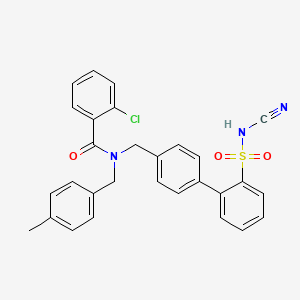
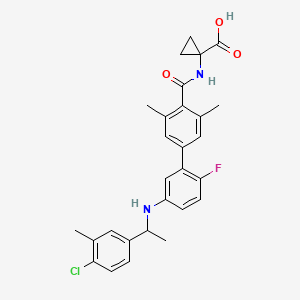
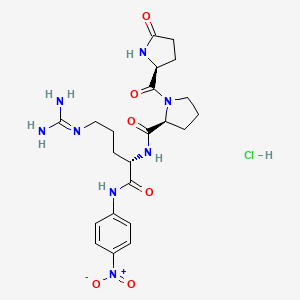
![3-(1H-indol-2-yl)-2-[[5-[2-(4-methylphenyl)ethynyl]thiophen-2-yl]sulfonylamino]propanoic acid](/img/structure/B610628.png)
